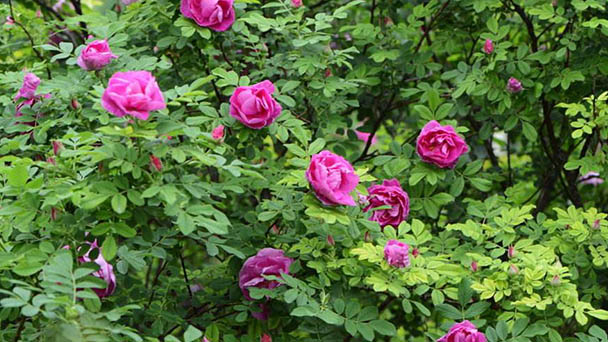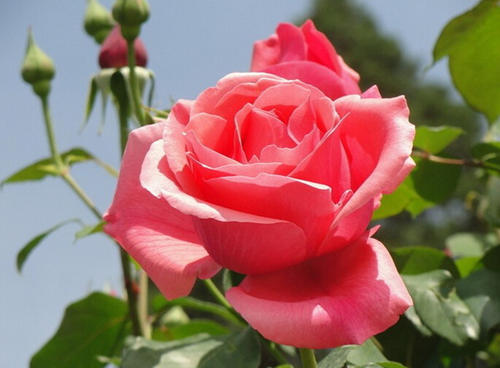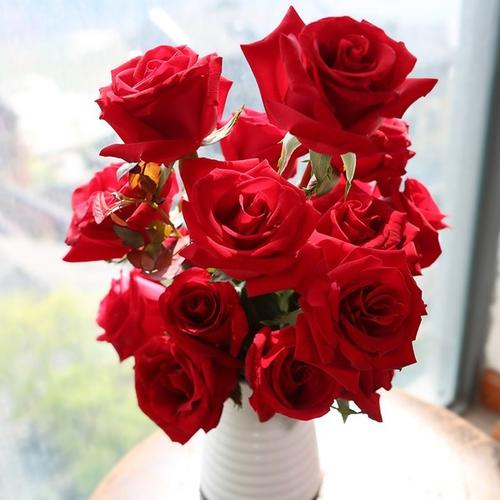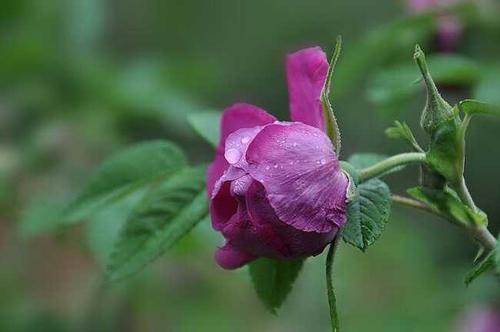Rose profile
Written by Maggie
Mar 23 2021

When Rose is used as an economic crop, its flowers are mainly used in food and refined rose oil. Rose oil is used in cosmetics, food, fine chemicals and other industries.
Rose picture
Rose morphological characteristics
Rose is an upright shrub, up to 2 meters high; the stem is thick and clumped.The branchlets are densely tormented with needles and glandular hairs, with upright or curved, pale yellow thorns, and the thorns are covered with hairs.
Rose leaflets are 5-9, with petioles 5-13 cm long. Leaflets are elliptic or elliptic obovate, 1.5-4.5 cm long, 1-2.5 cm wide, apex sharp or rounded, base round or broadly wedge-shaped, with edges. Rose sharp is serrated, dark green above, glabrous, leaf veins sunken, wrinkled, gray-green below, midvein protruding, network veins obvious, densely covered with villi and glandular hairs, sometimes not obvious. Rose petioles and leaf shafts are densely covered with villi and glandular hairs. The stipules are mostly adherent to the petiole, and the free part is ovate, with glandular serrations on the edge and villi underneath.
Rose flowers are solitary in leaf axils, or several clusters, bracts ovate. Margins are glandular hairs, outer tomentose. Pedicel length is 5 -22 5 mm, densely tomentose and glandular hairs. Rose flower diameter is 4-5.5 cm; sepals ovate Lanceolate, apex caudate acuminate, often with pinnate lobes that expand into leaf shapes, with sparse pilose on the top and densely pilose and glandular hairs on the bottom. Rose petals are obovate, double to semi-double petals, fragrant. Rose fruit is oblate, 2-2.5 cm in diameter, brick red, fleshy, smooth, with persistent sepals. Rose flowering period is from May to June, fruiting from August to September.

Rose habitat
Rose is native to North China, Japan and North Korea. Cultivated all over China. Rose is distributed in Eastern Asia, Bulgaria, India, Russia, the United States, North Korea and other places.
Rose is distributed in China in Beijing, Jiangxi Province, Sichuan Province, Yunnan Province, Qinghai Province, Shaanxi Province, Hubei Province, Xinjiang Uygur Autonomous Region, Hunan Province, Hebei Province, Shandong Province, Guangdong Province, Liaoning Province, Jiangsu Province, Gansu Province, Inner Mongolia Autonomous Region, Henan Province, Shanxi Province, Anhui Province and Ningxia Hui Autonomous Region.
Rose growth habit
Rose likes sunny, cold and drought-tolerant, well-drained, loose and fertile loam or light loam. Rose grows poorly in clay loam and does not bloom well. Rose should be planted in a well-ventilated place far away from the wall to prevent sunlight reflection, burn buds, and affect flowering.
Rose is a masculine plant. The Rose flower color is strong and the fragrance is strong with sufficient sunshine. When the sun is less than 8 hours in the growing season, Rose will grow long without flowering. The air humidity requirements of rose are not very strict. Rust and powdery mildew occur when the temperature is low and humidity is high; the flowering season requires a certain humidity in the air; and the oil production rate will be reduced when the temperature is dry. Rose does not have strict requirements on the pH of the soil, and it can grow normally from slightly acidic soil to slightly alkaline soil. In winter snow-covered areas, rose can tolerate low temperatures of -38°C to -40°C, and in snow-covered areas, rose can also tolerate low temperatures of -25°C to -30°C, but Rose cannot tolerate early spring dry winds. In areas where the soil has not been thawed and the ground is windy, the Rose branches are often blown dry; if the soil is thawed, the roots will continue to transport water and nutrients to the stems, and the wind cannot cause serious harm. Areas with a dryness greater than 4 need irrigation conditions for normal development.

Latest Updated
- Benefits of Bugleweed - 7 Science-backed Health Benefits
- Bugleweed Dangers & Side Effects - Is It Poisonous?
- How to Plant Evergreen Trees - What You Should Know
- When to Plant Evergreens - Grow Guide for Evergreen Trees
- 12 Wonderful Evergreen Shrubs for Your Garden
- 12 Popular Evergreen Plants with Pictures for Beginners
- When And How To Prune A Lilac Bush Like a Pro
- How to Grow & Care for Lilac Vine (Hardenbergia Violacea)
- Japanese Lilac Tree (Syringa Reticulata) Care & Propagation Guide
- Shumard Oak Pros and Cons - What to Know
Popular Articles
- Winter maintenance of Antirrhinum Majus
- How to Grow Terminalia Mantaly Tree
- How to Grow and Care for Crossostephium Chinense
- How to grow Antirrhinum Majus in spring
- Peristeria Elata (Dove Orchid) Profile: Info & Care Guide
- Underwatered Snake Plant (Sansevieria Trifasciata) - Signs And How To Fix
- How to Care for Brazilian Jasmine Plant (Mandevilla Sanderi)
- How to Grow & Care for Graptopetalum Purple Delight in Summer
- Rosa Chinensis (China Rose): Plant Growing & Care Tips
- How to Care for Baby Sun Rose (Aptenia Cordifolia)
